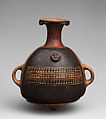Urpu (jar)
Not on view
Containers with globular bodies, pointed bases, long necks, and flared rims, known as urpus, were the most recognizable form of Inca imperial style ceramics. Large urpus—up to 45 inches high—were used to carry and serve aqha (chicha or corn beer) in ritual celebrations sponsored by the Inca state. Smaller versions, as this example, served votive purposes at sacred sites across the empire.
Many of the same features found on full-size urpus are replicated in small-scale urpus, including the pointed base that allowed large ones to be set into the earth for stability. On the shoulder of the chamber there is usually a central lug, often in the shape of a stylized head, and strap handles on either side. On full-size urpus, ropes were pulled through the handles and secured around the lug for carrying on the backs of porters. On this example, the neck was painted with red slip, and three registers of a diamond pattern were painted on one side of the body.
Further Reading and References
Cummins, Thomas B. F. Toasts with the Inca: Andean Abstraction and Colonial Images on Quero Vessels. Ann Arbor: University of Michigan Press, 2002.
Kusunoki, Ricardo, Cecilia Pardo and Julio Rucabado. Los incas. Más allá de un imperio. Lima: Museo del Arte, 2023.
Ochoa, Jorge F., Elizabeth K. Arce, and Roberto S. Argumedo. Queros: Arte Inka en vasos ceremonials. Lima: Banco de Crédito, 1998.
Shimada, Izumi, ed. The Inka Empire: A Multidisciplinary Approach. Austin: University of Texas Press, 2015.
This image cannot be enlarged, viewed at full screen, or downloaded.
This artwork is meant to be viewed from right to left. Scroll left to view more.




